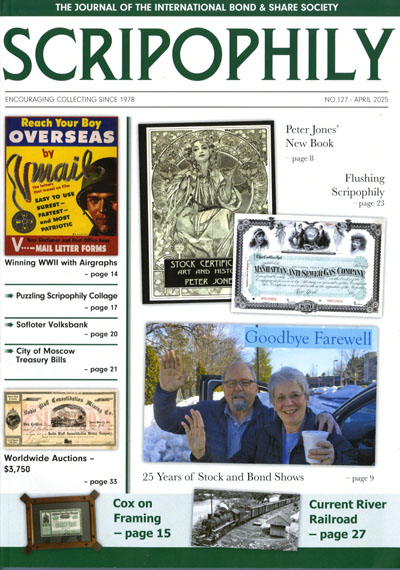Cox's Corner
 Scripophily Magazine, published by the International Bond and Share Society.
Scripophily Magazine, published by the International Bond and Share Society.
Scripophily is a magazine published by the International Bond & Share Society and is one of the premier benefits of membership. I have been greatly honored to write a column for Scripophily since 2007. I write articles for "Cox's Corner" in a conversational format, talking about issues that involve the hobby of collecting stocks and bonds. In general, I try to focus on overview issues and I usually end up writing about top of mind issues, commonly those subjects discussed recently with correspondents.
The hobby has changed a lot since I started cataloging railroad stocks and bonds. At that time, there were many dealers on both sides of the Atlantic and almost all issued periodic catalogs. Articles about stocks, bonds, and engravings appeared with some frequency in hobby periodicals such as Bank Note Reporter, Paper Money, and even occasionally in Coin World and CoinAge. Auctions were common, especially those conducted by R.M. Smythe in Memphis, New York and Strasburg, Pennsylvania.
Scripophily is a young hobby, dating from only the mid-1970s. In fact, the stock and bond hobby started at about the same time as the TRS-80, Commodore and Apple computers first hit the home market. By 1981, George LaBarre had published the first of three small illustrated catalogs showing prices of hundreds of stocks and bonds. Both LaBarre and R. M. Smythe were conducting mail and physical auctions of stocks and bonds in the mid-1980s. Between then and the mid-1990s, the hobby had proliferated a large number of collectors and dealers on both sides of the Atlantic. Dealer pricelists and catalogs had become the rule. There was a growing demand for price guidance in all specialties, driven partly by price and partly by a growing appreciation of rarity relative to price.
Hobbywide, perhaps one of the most under-appreciated developments at that time was the growth of the internet. Practically no one in the stock and bond hobby knew or paid attention to the founding of an obscure California company named AuctionWeb in 1995. After all, the Pew Research Center had polled Americans that year and found that only 14% of adults had internet access.
In fact, 42% of American adults claimed to have never even heard of the internet!
To the best of my knowledge Scripophily.com (Bob Kerstein) was the first American scripophily dealer to acquire an internet domain address in April, 1996. At least two German dealers acquired ".com" addresses that same year (martinaberg.com and lamassu.com.) Other early scripophily-related domains included numistoria.com (Guy Cifré), stocksearchintl.com (Pierre Boneau), antiquestocks.com (Fred Fuld III), stanleygibbons.com, cigarboxlabels.com (David Beach), pentenrieder.com (Historische Wertpapiere Pentenrieder), scottwinslow.com (Scott Winslow), glabarre.com (George LaBarre), and smytheonline.com (R. M. Smythe.)
As more stock and bond dealers acquired internet presences, three powerful, computer-driven forces combined to change the way scripophily sales had been conducted.
Printer output qualities and methods had been improving for quite awhile, Color laser printing had been developed as early as 1993 and by 2001, was sufficiently affordable for George LaBarre and FHW (Freunde Historischer Wertpapiere) to print full color catalogs. That move "raised the bar' on what collectors expected to see from their providers. Color printing also inflated costs for production. Dealers and auctioneers responded with higher commissions, fewer discounts, more limited catalog mailings and decreased mailing lists.
While storage costs for websites were not free, they had decreased enough for me to roll out coxrail.com. It only made sense. After all, I wanted to display images of certificates for my readers. Using the web, I could display full-color images of stocks and bonds almost for free. And while very few foresaw the problems ahead, therein lay the "writing on the wall." Why couldn't dealers sell on the web where display costs were fractions of physical printing?
Of course, AuctionWeb, which changed its name to eBay in 1997, had already thought the same way. It had pioneered the idea of a person-to-person auction model that no one knew would affect scripophily sales so drastically. I do not know exactly when someone sold the first collectible stock certificate on eBay, but it must have been very early. Certificate dealer Kenneth Holter (now deceased) was a major contributor to this project in the early days. Between July 1, 1996 and the end of that year, Ken had contributed almost 500 images that he had printed from eBay offerings.
Based upon heavy submittals from Ken and other collectors and dealers, I began sending out quarterly newsletters to my contributors in March, 1999. I set up the coxrail website in June, 2000, re-designed it a few months later and then launched the online database in June, 2001. It was about that time I started hearing complaints from dealers about the impact of ultra-low eBay prices. Fear was evident. Not only was the eBay auction model eating into certificate dealer sales, it was affecting coin, currency, stamps, and most other collectibles.
After several delays, I decided to self-publish the second edition of my catalog in 2003. Between the published catalog and the website, collectors contributed an increasing number of images and other information. The number of color images available to everyone grew to over 10,000 in early 2007. About that time, Brian Mills, editor of Scripophily, asked if I would write an article for the magazine. How could I say "no" to the honor?
Since then, I've tried to write an article for every issue. Sadly, I failed a couple times because of competing demands on my time, Still, I try to write about things I see in the hobby, often in response to correspondence from my contributors. I try not to write about rail-related certificates unless subjects in that specialty reflect issues in the greater hobby.
At left is a full collection of Scripophily articles arranged by date. Below is the same collection arranged alphabetically by title.